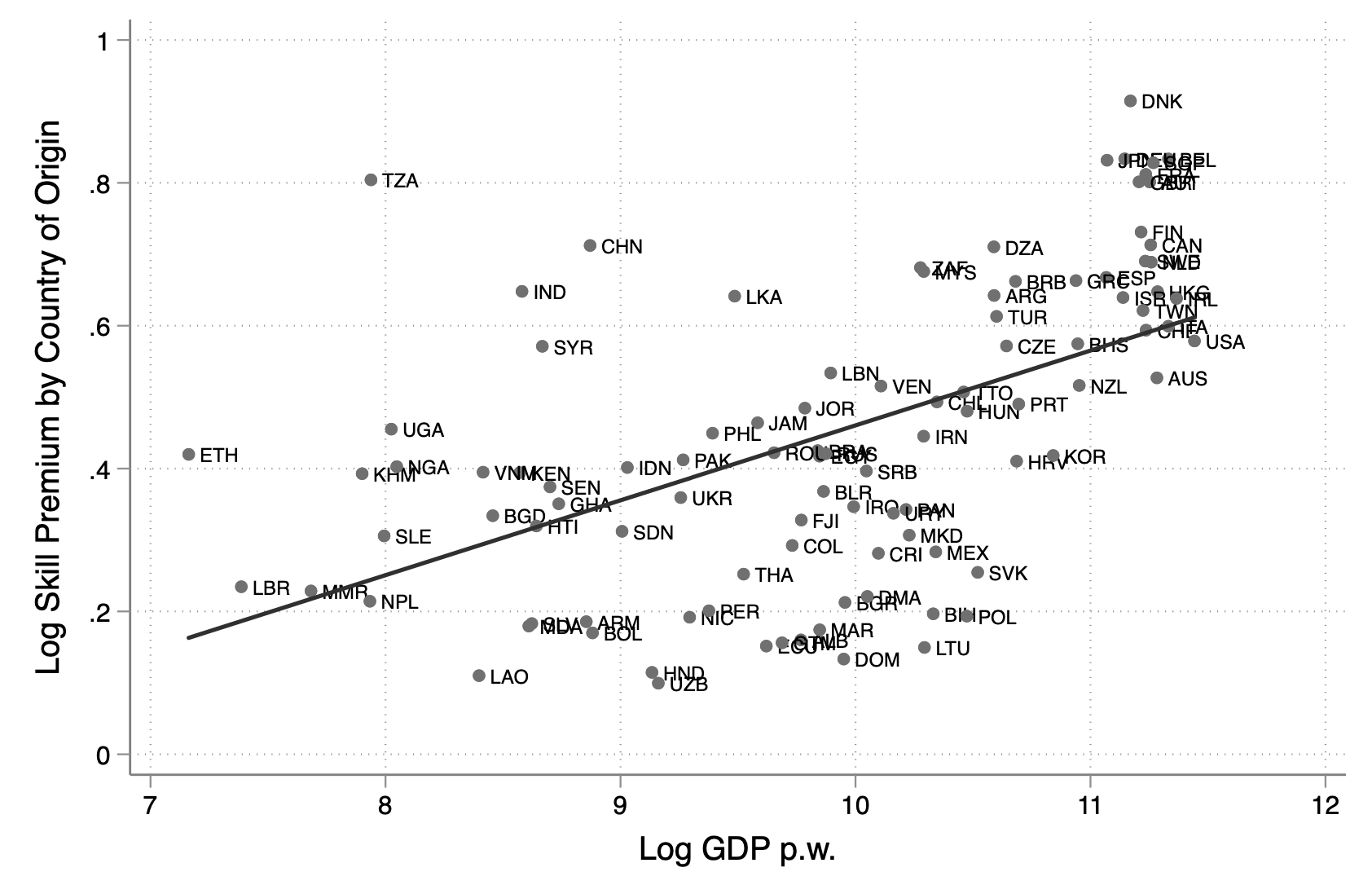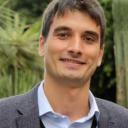
Highly educated workers are relatively more productive in rich countries, largely due to a more skill-biased technological environment
The availability of highly educated labour varies dramatically between poorer and richer countries. Consider, for example, India and the United States. In 2010, the share of the Indian working age population with some tertiary education was 9%, while the corresponding share in the US was 56% (Barro and Lee 2013).
At the same time, differences in the wage premium for highly educated labour appear to be small. According to the estimates collected by Caselli et al. (2014), in both India and the United States, an additional year of schooling is associated with a wage increase of approximately 10%; more generally, returns to schooling are only weakly correlated with development.
The link between productivity and wages for skilled workers
The combination of large differences in the quantity of skilled labour and small differences in the skill premium has led previous work to conclude that the relative efficiency of high-skill workers increases with development (Caselli and Coleman 2006). The logic of this argument is simple: under standard assumptions, the abundance of skilled workers should push down their relative remuneration in rich countries, as the services they produce are more widely available; the lack of this pattern in the data suggests that the downward pressure of the skill premium is compensated by skilled workers in rich countries being relatively more productive, which pushes up their wage.
The literature has suggested two possible reasons for this.
- On one hand, the productive environment in rich countries might be more ‘skill-biased’, either because (i) firms adopt technologies more suitable for skilled workers, as proposed in Caselli and Coleman (2006), or (ii) more generally, the institutional setting or sectoral composition in these countries are favourable to high-skill labour.
- On the other hand, as in Jones (2014), high-skilled workers might embody more human capital in rich countries, because of differences in educational quality, training, or workers’ intrinsic characteristics.
The distinction between these two explanations matters greatly for development accounting: if the ‘human capital view’ is correct, the entire cross-country variation in GDP per worker can be accounted for by highly-educated labour having relatively more human capital in rich countries; under the alternative view, the contribution of relative human capital is much lower (Caselli and Ciccone 2019).
Measuring relative skill efficiency with micro data
In recent work, I revisit both the measurement and the interpretation of gaps in relative skill efficiency across countries (Rossi 2022). Using micro-level data across 12 countries at different levels of development, I construct comparable measures of the relative supply and wage premium of workers with some tertiary education. Differently from previous work, these measures incorporate the cross-country variation in employment rates and hours worked, and are based on comparable wage data (as opposed to collections of estimated returns to schooling from different sources).
Based on these measures, and assuming a standard production function, I compute for each country the implied relative efficiency of high-skill labour.
- As shown in Figure 1, there is a tight correlation with GDP per worker. The productivity gap between high- and low-skill labour is more than 20 times larger in the United States compared to India, a difference of similar magnitude to the one in GDP per worker between these two countries.
- To a large extent, the cross-country dispersion in relative skill efficiency is not driven by differences in sectoral composition, in the incidence of self-employment, or in the returns to gender and experience.
Figure 1

Note: The figure plots log relative skill efficiency and log GDP per worker for 12 countries. Relative skill efficiency is normalised to take value 1 (0 in log) for the United States. The solid line represents the best linear fit.
Interpreting relative skill efficiency: Evidence from international migrants
Why are high-skilled workers more productive in rich countries? I exploit variation in the skill premia of international migrants to shed light on this question. Intuitively, foreign-educated migrants employed in the same labour market are subject to an equally skill-biased production environment, but have different levels of human capital depending on the quality and features of the educational environment in their country of origin.
Comparing skill premia across nationalities within the same host country thus allows us to separate cross-country differences in the relative human capital of high-skill labour, and in the skill bias of production.
Figure 2

Note: The figure plots the log skill premium across US immigrants’ countries of origin against the log GDP per worker in the country of origin. The solid line shows the best linear fit.
Figure 2 displays skill premia for US immigrants against GDP per worker in the country of origin. High-skill migrants from rich countries are relatively more remunerated in the US, consistent with their relative human capital being higher. However, these cross-nationality differences are small compared to the cross-country gaps in relative skill efficiency displayed in Figure 1.
Indeed, this evidence (combined with similar patterns from other host countries) leads me to conclude that less than 10% of the variation in overall relative skill efficiency can be explained by the human capital endowments of highly educated labour. To a large extent, it is the productive environment that makes high-skill labour relatively more efficient in rich countries.
Implications for cross-country differences in human capital
But how can my findings–that the cross-country variation in the human capital gap between high- and low-skill workers is somewhat limited–be reconciled with a recent literature that finds a large contribution of human capital in accounting for cross-country income differences (Hendricks and Schoellman 2018)?
This implies that a large contribution of human capital to income differences requires large uniform gaps across skill levels meaning that all workers, irrespective of their skill level, have higher human capital in rich countries. This resonates with recent work by Hendricks and Schoellman (2022), which shows that wage gains of high- and low-skill migrants to the US are consistent with significant human capital gaps for both groups.
This conclusion puts important restrictions on theories of human capital accumulation and economic development. Large cross-country gaps in human capital for all educational levels call for attention towards factors affecting the human capital formation of all workers, which become natural candidates to explain the cross-country variation in human capital. This includes the quality of early education (Fazzio et al 2021), family inputs (De Philippis and Rossi 2021), cultural traits (Hanushek et al. 2020), and the opportunities to accumulate skills over the life cycle (Lagakos et al. 2017).
What makes the productive environment more skill-biased in rich countries?
The accounting results in Rossi (2022) leave open the questions of why (and through which channels) production is more skill-biased in rich countries. A popular view is that differences in skill bias are endogenous responses to the availability of high-skill labour: as highly educated workers are abundant in rich countries, firms in such countries have stronger incentives to adopt technologies that complement these workers. The idea that technology adoption responds to factor availability received empirical support in a variety of settings (e.g. Beaudry Doms and Lewis 2010).
In addition, cross-country differences in institutional quality, in the organisation of production, and in the prevalence of large and modern corporations might all disproportionately benefit high-skill workers in rich countries, possibly also contributing to explaining why more individuals choose to accumulate skills in those countries. Documenting and quantifying these channels are important tasks for future work.
References
Barro, R and J W Lee (2013), “A new data set of educational attainment in the world, 1950-2010”, Journal of Development Economics 104 (C): 184–198.
Beaudry, P, M Doms, and E Lewis, 2010. "Should the Personal Computer Be Considered a Technological Revolution? Evidence from U.S. Metropolitan Areas," Journal of Political Economy 118(5), pages 988-1036.
Caselli, F and A Ciccone (2019) "The human capital stock: A generalised approach: Comment”, American Economic Review 109(3): 1155-74.
Caselli, F and W J Coleman (2006), “The world technology frontier”, American Economic Review 96(3): 499–522.
Caselli, F, J Ponticelli, and F Rossi (2016), A new data set on Mincerian returns to technology differences across space and time, Princeton University Press.
De Philippis, M and F Rossi (2021), “Parents, schools and human capital differences across countries”, Journal of the European Economic Association 19(2):1364–1406.
Fazzio, I et al. (2021), “Large learning gains in pockets of extreme poverty: Experimental evidence from Guinea Bissau”, Journal of Public Economics 199: 104385.
Hanushek, E, L Kinne, P Lergetporer, and L Woessmann (2020), "Culture and student achievement: The intertwined roles of patience and risk-taking", NBER Working Paper 27484.
Hendricks, L and T Schoellman (2018), “Human capital and development accounting: New evidence from wage gains at migration”, The Quarterly Journal of Economics 133 (2): 665–700.
Hendricks, L and T Schoellman (2020), "Skilled labour productivity and cross-country income differences", Working Paper.
Jones, B (2014), “The human capital stock: A generalised approach,” American Economic Review 104(11): 3752–3777.
Lagakos, D et al. (2017), “Life-cycle wage growth across countries,” Journal of Political Economy 126(2):797-849.
Rossi, F (2022), “The relative efficiency of skilled labour across countries: Measurement and interpretation”, American Economic Review 112(1): 235–266.

